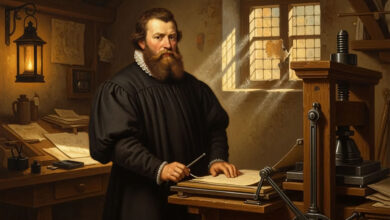Sir Arthur Conan Doyle stands among the most influential literary figures of the late nineteenth and early twentieth centuries. Best known as the creator of Sherlock Holmes, Doyle’s contributions to literature, popular culture, and even science and spiritualism reveal a complex and fascinating man. His works have enthralled generations, while his life story offers a compelling narrative of ambition, innovation, controversy, and enduring impact.
Early Life and Education
Arthur Ignatius Conan Doyle was born on 22 May 1859 in Edinburgh, Scotland, to a family of Irish Catholic descent. His father, Charles Altamont Doyle, was an artist and architect, while his mother, Mary Doyle, was a well-read and spirited woman who would become a powerful influence on her son’s imagination. Doyle’s childhood was marked by both hardship and inspiration. His father struggled with alcoholism and mental health, leading to financial instability, but his mother’s storytelling instilled in him an early love of literature.
Doyle’s education began at the Jesuit preparatory school Hodder Place, Stonyhurst, followed by Stonyhurst College itself. Though he later criticised the strictness of Jesuit education, it provided him with a solid grounding in the classics and the discipline that would serve him throughout his life. After leaving school, Doyle studied medicine at the University of Edinburgh. There, he encountered Dr Joseph Bell, whose keen powers of observation and deduction would later inspire Sherlock Holmes’s methods.
Beginnings as a Writer
While pursuing his medical studies, Doyle began writing short stories to supplement his income. His first published story, “The Mystery of Sasassa Valley,” appeared in 1879 in Chambers’s Edinburgh Journal. Encouraged by modest success, he continued to write, experimenting with genres ranging from adventure to science fiction.
After graduating in 1881, Doyle embarked on a career as a ship’s doctor, travelling to the West African coast and the Arctic. These early travels provided material for his later adventure stories. Eventually, he settled as a general practitioner in Southsea, Portsmouth, where, during quiet periods, he continued to write. It was during this time that he created the character who would make him famous worldwide.
The Birth of Sherlock Holmes
In 1886, Doyle wrote “A Study in Scarlet”, introducing Sherlock Holmes and Dr John Watson. The novel, published in 1887 by Ward, Lock & Co., met with favourable reviews but modest sales. Holmes, however, was unlike any detective previously seen in literature, coldly logical, eccentric, and almost superhuman in his powers of deduction. Dr Watson, the everyman narrator, provided the perfect foil, making the stories accessible and engaging.
The true breakthrough for Holmes and Doyle came with the publication of “The Adventures of Sherlock Holmes” in The Strand Magazine in 1891. Serialisation brought Holmes into the homes of thousands and made Doyle a household name. The stories, such as “A Scandal in Bohemia”, “The Adventure of the Speckled Band”, and “The Adventure of the Blue Carbuncle”, became instant classics.
The Burden of Success and “The Final Problem”
Doyle soon found himself typecast as a detective writer, much to his frustration. He aspired to be recognised for his historical fiction, such as “Micah Clarke” and “The White Company”, but the public’s appetite for Holmes was insatiable. In 1893, seeking to free himself from his most famous creation, Doyle killed off Holmes in “The Final Problem”, sending the detective over the Reichenbach Falls in mortal combat with Professor Moriarty.
The public outcry was unprecedented; readers wore black armbands, letters of protest flooded in, and magazine subscriptions plummeted. Doyle, however, stood firm, at least for a time. Eventually, financial pressure and persistent demand led him to resurrect Holmes in 1901 with “The Hound of the Baskervilles”, set before Holmes’s supposed death, and later, in “The Adventure of the Empty House”, Holmes was revealed to have survived.
Beyond Baker Street: Other Literary Pursuits
Although Holmes remains Doyle’s most enduring creation, his literary output was vast and varied. He penned historical novels, such as “Sir Nigel” and “The White Company”, which reflect his fascination with chivalry and medieval England. Doyle also wrote science fiction, most notably “The Lost World” (1912), featuring the irascible Professor Challenger and his dinosaur-filled plateau. This work is often seen as a precursor to modern adventure and science fiction films.
Doyle’s short stories, plays, poetry, and non-fiction works further demonstrate his versatility. He wrote treatises on war, memoirs such as “Memories and Adventures”, and controversial works defending causes in which he believed. His writings on the Boer War and the Belgian atrocities in the Congo showcase his commitment to justice and humanitarianism.
Public Life and Political Involvement
Doyle was not content to be merely a writer; he was also a public figure and activist. He campaigned for the reform of British divorce laws and stood twice for Parliament, though unsuccessfully. He was a passionate advocate for justice and used his fame to right judicial wrongs. His intervention in the cases of George Edalji and Oscar Slater, two men wrongly convicted of crimes, led to their exoneration and influenced reforms in the British legal system.
In 1902, King Edward VII knighted Doyle, not for Sherlock Holmes, but for his services during the Boer War, particularly his pamphlet “The War in South Africa: Its Cause and Conduct”, which defended British actions during the conflict.
Belief in Spiritualism
One of the most controversial aspects of Doyle’s life was his ardent belief in spiritualism. The loss of several family members, including his son Kingsley during the First World War, deepened his interest in the afterlife. Doyle became one of the leading public advocates of spiritualism, believing fervently in communication with the dead. He wrote extensively on the subject and lectured around the world, often to sceptical audiences.
Doyle’s defence of spiritualism brought him into conflict with contemporaries, notably the illusionist Harry Houdini, who saw mediumistic practices as fraudulent. Despite criticism, Doyle never wavered in his convictions, seeing spiritualism as a continuation of his quest for truth.
Personal Life
Doyle married twice. His first wife, Louisa Hawkins, whom he married in 1885, suffered from tuberculosis and died in 1906. Their marriage was marked by love, devotion and the birth of two children, though Louisa’s illness overshadowed this. Doyle later married Jean Leckie, with whom he had three further children. He was known for his generosity, warmth, and sporting prowess. He played cricket for the Marylebone Cricket Club and was an early enthusiast of skiing, golf, and football.
Last Years and Death
Sir Arthur Conan Doyle spent his later years at Windlesham, his home in Crowborough, Sussex. He continued to write and campaign for spiritualism until his death on 7 July 1930, aged 71. His last words, reportedly addressed to his wife, were “You are wonderful.”
He was buried in the churchyard at Minstead in the New Forest, Hampshire, fulfilling his wish to rest in peace among the trees and birds he loved.
Legacy
The legacy of Sir Arthur Conan Doyle is impossible to overstate. Sherlock Holmes has become a cultural icon, inspiring countless adaptations, pastiches, films, and television series. The detective’s methods have influenced not only writers but also real-world forensic science and criminal investigation. Holmes’s address, 221B Baker Street, is among the most famous in literature.
Beyond Holmes, Doyle’s works continue to be read and appreciated for their craft, imagination, and insight into the human condition. His advocacy for justice contributed to legal reforms, while his fascination with the unknown speaks to the enduring human search for meaning.
Doyle’s life was itself a story, one of restless invention, resilience in the face of adversity, and a passionate belief in the power of reason and wonder. He remains, more than ninety years after his death, not only the creator of the world’s greatest detective, but a figure whose own mysteries still invite exploration.
Final Thoughts
Sir Arthur Conan Doyle was a man of contradictions and convictions, a rational doctor who believed in the supernatural, a writer who resented his greatest creation, a public figure whose impact extended far beyond fiction. His life and work exemplify the richness and complexity of the Victorian and Edwardian eras, and as long as stories are told and mysteries are solved, the legacy of Conan Doyle will endure.
Sir Arthur Conan Doyle FAQ
Sir Arthur Conan Doyle was a Scottish author and physician best known for creating the fictional detective Sherlock Holmes. Born in Edinburgh in 1859, he combined his medical background with a sharp sense of storytelling to craft logical, tightly plotted mysteries that redefined detective fiction.
Doyle was inspired by one of his university professors, Dr. Joseph Bell, who used keen observation and deduction to diagnose patients. Doyle adapted these methods into the investigative style of Sherlock Holmes, creating a detective whose reasoning mirrored scientific precision.
Beyond Holmes, Doyle wrote historical novels like Micah Clarke and The White Company, the science-fiction adventure The Lost World, and essays and pamphlets on spiritualism, war, and justice. His literary range stretched far beyond detective fiction.
After the deaths of close family members during World War I, Doyle turned to spiritualism as a source of comfort and conviction. He genuinely believed communication with the dead was possible and spent much of his later life lecturing and writing about it.
Doyle’s impact on literature is immense. His creation of Sherlock Holmes established the template for modern detective fiction, influencing countless writers and screen adaptations. The logical deduction, sidekick dynamic, and atmospheric London setting remain staples of the genre today.




